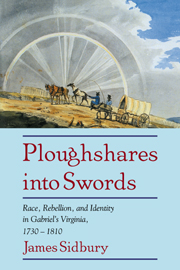Book contents
- Frontmatter
- Contents
- Acknowledgments
- Introduction
- Prologue: From Blacks in Virginia to Black Virginians
- 1 The emergence of racial consciousness in eighteenth-century Virginia
- Part I Cultural process: Creolization, appropriation, and collective identity in Gabriel's Virginia
- Part II Social practice: Urbanization, commercialization, and identity in the daily life of Gabriel's Richmond
- 5 The growth of early Richmond
- 6 Labor, race, and identity in early Richmond
- 7 Race and constructions of gender in early Richmond
- Epilogue: Gabriel and Richmond in historical and fictional time
- Appendix: Richmond households in 1784 and 1810
- Index
5 - The growth of early Richmond
Published online by Cambridge University Press: 04 August 2010
- Frontmatter
- Contents
- Acknowledgments
- Introduction
- Prologue: From Blacks in Virginia to Black Virginians
- 1 The emergence of racial consciousness in eighteenth-century Virginia
- Part I Cultural process: Creolization, appropriation, and collective identity in Gabriel's Virginia
- Part II Social practice: Urbanization, commercialization, and identity in the daily life of Gabriel's Richmond
- 5 The growth of early Richmond
- 6 Labor, race, and identity in early Richmond
- 7 Race and constructions of gender in early Richmond
- Epilogue: Gabriel and Richmond in historical and fictional time
- Appendix: Richmond households in 1784 and 1810
- Index
Summary
The recorded history of what became Richmond can be traced back to the earliest period of English colonization when the leader of the powerful indigenous Powhatan Confederacy that dominated eastern Virginia held court there. It might also embrace Nathaniel Bacon, who began his 1676 rebellion in Henrico County, and William Byrd I, who lived near and traveled through the area to trade with Native Americans. But the history of Richmond itself begins with Byrd's son and heir, William Byrd II, who inherited the land that came to comprise Richmond and who founded the town in 1737.
Byrd built a small settlement on Shockoe Creek at the falls of the James River well before he made formal plans for the town. During the 1720s and 30s he built a tobacco warehouse that brought him “at least £50 per annum” and a mill to grind the grain grown on his and other area plantations. In 1730 the House of Burgesses increased the value of Byrd's investment by designating his warehouse an official site for the inspection and storage of tobacco destined to be shipped to European markets. No doubt Byrd used his extensive political connections to encourage the legislature to seat a public warehouse on his land, but the falls of the James represented an obvious choice: it was indeed, as Byrd claimed, a place “naturally intended” for a market “where the traffic of the outer inhabitants” of Virginia “must center.” To encourage development he had a neighbor survey the land and lay out lots, which he offered to sell to anyone who would build a “House in Three Years Time.”
- Type
- Chapter
- Information
- Ploughshares into SwordsRace, Rebellion, and Identity in Gabriel's Virginia, 1730–1810, pp. 151 - 183Publisher: Cambridge University PressPrint publication year: 1997

